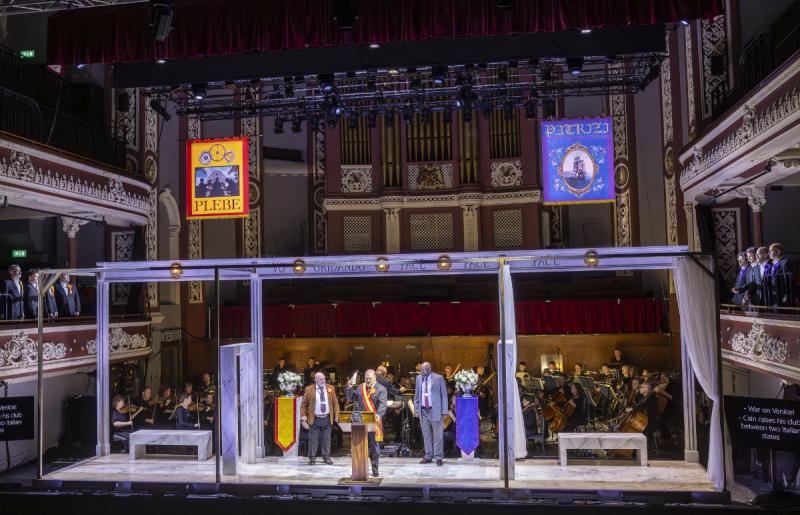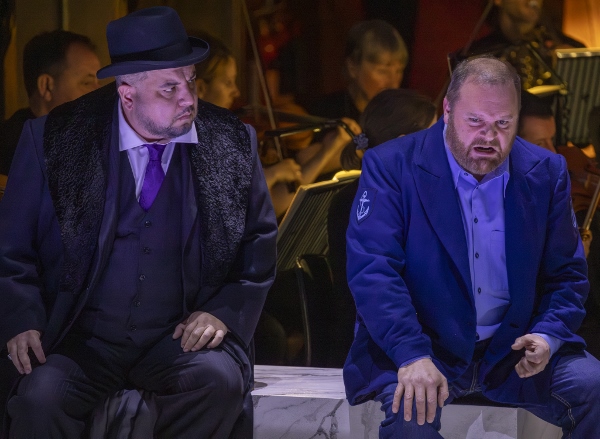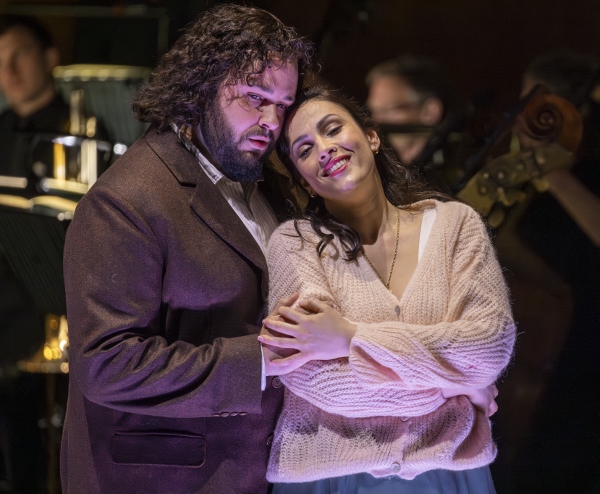Simon Boccanegra, Opera North review - ‘dramatic staging’ proves its worth | reviews, news & interviews
Simon Boccanegra, Opera North review - ‘dramatic staging’ proves its worth
Simon Boccanegra, Opera North review - ‘dramatic staging’ proves its worth
Verdi’s political tragedy - and plea for peace - has impact in a grand Yorkshire setting

Opera North have recently pioneered a way of presenting some big works which they call “dramatic concert stagings”, performing in concert halls as well as theatres, with the orchestra on the platform behind the singers and a minimalist set, and the principals in present-day costumes symbolic of characters’ type.
Some have had video projection as a backdrop, but it’s also been dispensable where necessary. This one has none, but the concept is much more than a concert performance and completely justified by its impact in theatrical terms.
They’ve opened in St George’s Hall, Bradford, as an early highspot of the “City of Culture” year there, rather than in their home base of Leeds, and it will go on to Nottingham, Gateshead, Liverpool, Hull and finally the South Bank Centre in London. The Yorkshire city’s Victorian edifice, speaking grandly of municipal pride, is well suited to a plot that hinges on historic political feuds – whether the internal architecture of the other venues will adapt so well will be for others to judge. And in PJ Harris’s production (and it is worthy of the word), with design by Anna Reid, the front of the platform is filled by a three-section, open-sided structure implying different places and the side-rooms to them: over the top is the moving plea for peace made by Boccanegra in the famous Council Chamber scene (quoting Petrarch) “I vo gridando, ‘Pace, pace, pace’”, and suspended banners on each side, along with campaigners’ coloured rosettes on their costumes, represent the warring parties of medieval Genoa – the Plebeians and Patricians whose fratricidal rivalry is the mainspring of the story.
And in PJ Harris’s production (and it is worthy of the word), with design by Anna Reid, the front of the platform is filled by a three-section, open-sided structure implying different places and the side-rooms to them: over the top is the moving plea for peace made by Boccanegra in the famous Council Chamber scene (quoting Petrarch) “I vo gridando, ‘Pace, pace, pace’”, and suspended banners on each side, along with campaigners’ coloured rosettes on their costumes, represent the warring parties of medieval Genoa – the Plebeians and Patricians whose fratricidal rivalry is the mainspring of the story.
And the entire building in Bradford has been used to stage the political clashes and near-riotous crowd scenes that surround the gradually unravelling relational tangle of the main characters, the Chorus of Opera North appearing at first on the sides of the circle seating as party supporters, and later singing as a distant choir for the off-stage wedding and also bursting in from the stalls-level side corridors as a baying mob. It works very well, with the help of two assistant conductors following CCTV screens as Antony Hermus, the company’s principal guest conductor, takes charge of all the musical impact of the score.
This was Verdi’s final, 1881 version of the opera first created by him 24 years earlier, with libretto mainly by Francesco Piave. In April last year Sir Mark Elder, with the Hallé and using the Chorus of Opera North, recorded the 1857 version and performed it in the Bridgewater Hall, Manchester – making a compelling case for its own merits which has been reinforced by the issue of the CD from Opera Rara around a week ago.
The 1881 version, revised in association with Arrigo Boito, the librettist of the late masterpieces Otello and Falstaff, is the one that gave birth to the Council Chamber scene (in place of a gaudy carnival finale that didn’t advance the plot or make any particular point about the story), and there’s no denying that the whole re-think brought us some of Verdi’s most brilliant dramatic music, as well as enabling him to tighten up and refine his earlier work in a variety of other places. The new scene had a message for his own times: as Italy was now formally united but still riven by factionalism, his hero’s appeal for peace and unity was a plea from his own heart, too.
The atmosphere of foreboding is set from the start (though the Preludio was shortened and lost its original punching vehemence in Verdi's later version) by the dark tones of the orchestra under Antony Hermus – the only point where balance seemed a trifle agley as it enveloped the male semi-chorus in its opening lines – but in every other respect the vocal lines were never under threat from the on-stage players and the totality of the huge textures Verdi creates was magnificent.
Though there is a love triangle, of a kind, within it, Simon Boccanegra is essentially an opera about politics – and the hard, lonely path trodden by a leader who appeals for reconciliation, not conflict. In the end, he loses his life because of it. The plot is notoriously complex: a Prologue is set 25 years before the rest of the action, in which we learn that Boccanegra, an ex-pirate, becomes Doge (Governor) of Genoa and fathers a child with the wife of his great enemy, Fiesco. A quarter-century later, the girl has grown up and is the ward of Fiesco – neither he nor Boccanegra knows that she, Amelia, is their grand-daughter and daughter, respectively. But she’s in love with a sworn enemy of Boccanegra called Gabriele. That’s all revealed by halfway through Act One, scene one, and there’s more to come – the word “vendetta” emerging strongly and repeatedly, as Paolo, the man who helped Boccanegra win the votes of the people in the first place, becomes both his enemy and a rival to Gabriele for Amelia’s hand.  The casting of the principals’ roles has achieved a remarkable balance of mature and younger voices. Roland Wood in the title role (pictured above with Vazgen Gazaryan left) is an inspired choice – his maturity and ability to bring both authority and a noble purity of tone to it, combined with committed acting of the emotions it requires, are formidable, and there was great beauty in his “Piango su voi” in the Council Chamber scene. Vazgen Gazaryan (as Fiesco) has the rich low register appropriate for his character, and presents effectively the change of tone attributable to his ageing and bitter experience in the story. Mandla Mndebele as Paolo Albiani may not equal them for resonance but acts the thwarted power player and unrequited lover clearly – he is the out-and-out bad guy, but he finds depth there.
The casting of the principals’ roles has achieved a remarkable balance of mature and younger voices. Roland Wood in the title role (pictured above with Vazgen Gazaryan left) is an inspired choice – his maturity and ability to bring both authority and a noble purity of tone to it, combined with committed acting of the emotions it requires, are formidable, and there was great beauty in his “Piango su voi” in the Council Chamber scene. Vazgen Gazaryan (as Fiesco) has the rich low register appropriate for his character, and presents effectively the change of tone attributable to his ageing and bitter experience in the story. Mandla Mndebele as Paolo Albiani may not equal them for resonance but acts the thwarted power player and unrequited lover clearly – he is the out-and-out bad guy, but he finds depth there.
The young lovers are young singers (pictured above): Andrés Presno as Gabriele is a great heroic lover in the Italian tradition – he’s sung for Opera North before and is able to react intelligently and use his vocal potential wisely. And Sara Cortolezzis, making her Opera North debut as Amelia, inhabits the role that must be a stand-out in the story, as she alone brings feminine determination to reconcile the warring men. From the Act One aria “Come in quest’ora bruno” through to the end she shows a sustained ability to bring both fullness of tone at the top of the range and a lovely intermediate tone that floats through the ensembles, including the peak of the Council Chamber scene as she intervenes dramatically and ends the ensemble with a perfect delicate trill.
- Further performances on 29 April at the Royal Concert Hall Nottingham, 2 May at The Glasshouse Gateshead, 11 May at Liverpool Philharmonic Hall, 17 May at Hull City Hall, and 24 May at the Southbank Centre London
rating
Explore topics
Share this article
The future of Arts Journalism
You can stop theartsdesk.com closing!
We urgently need financing to survive. Our fundraising drive has thus far raised £49,000 but we need to reach £100,000 or we will be forced to close. Please contribute here: https://gofund.me/c3f6033d
And if you can forward this information to anyone who might assist, we’d be grateful.

Subscribe to theartsdesk.com
Thank you for continuing to read our work on theartsdesk.com. For unlimited access to every article in its entirety, including our archive of more than 15,000 pieces, we're asking for £5 per month or £40 per year. We feel it's a very good deal, and hope you do too.
To take a subscription now simply click here.
And if you're looking for that extra gift for a friend or family member, why not treat them to a theartsdesk.com gift subscription?
more Opera
 Buxton International Festival 2025 review - a lavish offering of smaller-scale work
Allison Cook stands out in a fascinating integrated double bill of Bernstein and Poulenc
Buxton International Festival 2025 review - a lavish offering of smaller-scale work
Allison Cook stands out in a fascinating integrated double bill of Bernstein and Poulenc
 Tosca, Clonter Opera review - beauty and integrity in miniature
Happy surprises and a convincing interpretation of Puccini for today
Tosca, Clonter Opera review - beauty and integrity in miniature
Happy surprises and a convincing interpretation of Puccini for today
 Hamlet, Buxton International Festival review - how to re-imagine re-imagined Shakespeare
Music comes first in very 19th century, very Romantic, very French operatic creation
Hamlet, Buxton International Festival review - how to re-imagine re-imagined Shakespeare
Music comes first in very 19th century, very Romantic, very French operatic creation
 Falstaff, Glyndebourne review - knockabout and nostalgia in postwar Windsor
A fat knight to remember, and snappy stagecraft, overcome some tedious waits
Falstaff, Glyndebourne review - knockabout and nostalgia in postwar Windsor
A fat knight to remember, and snappy stagecraft, overcome some tedious waits
 Salome, LSO, Pappano, Barbican review - a partnership in a million
Asmik Grigorian is vocal perfection in league with a great conductor and orchestra
Salome, LSO, Pappano, Barbican review - a partnership in a million
Asmik Grigorian is vocal perfection in league with a great conductor and orchestra
 Semele, Royal Opera review - unholy smoke
Style comes and goes in a justifiably dark treatment of Handelian myth
Semele, Royal Opera review - unholy smoke
Style comes and goes in a justifiably dark treatment of Handelian myth
 Le nozze di Figaro, Glyndebourne review - perceptive humanity in period setting
Mostly glorious cast, sharp ideas, fussy conducting
Le nozze di Figaro, Glyndebourne review - perceptive humanity in period setting
Mostly glorious cast, sharp ideas, fussy conducting
 Fidelio, Garsington Opera review - a battle of sunshine and shadows
Intimacy yields to spectacle as Beethoven's light of freedom triumphs
Fidelio, Garsington Opera review - a battle of sunshine and shadows
Intimacy yields to spectacle as Beethoven's light of freedom triumphs
 Dangerous Matter, RNCM, Manchester review - opera meets science in an 18th century tale
Big doses of history and didaction are injected into 50 minutes of music theatre
Dangerous Matter, RNCM, Manchester review - opera meets science in an 18th century tale
Big doses of history and didaction are injected into 50 minutes of music theatre
 Mazeppa, Grange Park Opera review - a gripping reassessment
Unbalanced drama with a powerful core, uninhibitedly staged
Mazeppa, Grange Park Opera review - a gripping reassessment
Unbalanced drama with a powerful core, uninhibitedly staged
 Saul, Glyndebourne review - playful, visually ravishing descent into darkness
Ten years after it first opened Barrie Kosky's production still packs a hefty punch
Saul, Glyndebourne review - playful, visually ravishing descent into darkness
Ten years after it first opened Barrie Kosky's production still packs a hefty punch
 Così fan tutte, Nevill Holt Festival/Opera North review - re-writing the script
Real feeling turns the tables on stage artifice in Mozart that charms, and moves
Così fan tutte, Nevill Holt Festival/Opera North review - re-writing the script
Real feeling turns the tables on stage artifice in Mozart that charms, and moves

Add comment